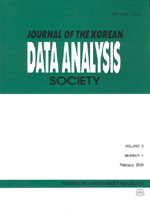국내 화력 발전회사의 연료 및 노동 효율성과 생산성 변화
Efficiency and Productivity Change of Korean Thermoelectric Power Companies
- 한국자료분석학회
- Journal of The Korean Data Analysis Society (JKDAS)
- Vol.13 No.6
-
2011.123215 - 3233 (19 pages)
- 31

본 연구는 자료포락분석(DEA)을 이용하여 국내 5개 화력 발전회사(SE발전, S발전, EW발전, W발전, M발전)의 연료 및 노동 효율성을 분석하고 맘퀴스트(Malmquist) 생산성 변화지수를 측정하였다. 분석기간은 2003년부터 2010년까지 8년간이다. 효율성 분석은 투입기준 CCR모형과 투입기준 BCC모형을 이용하였다. 투입물은 석탄, 유류, LNG, 생산직 종업원 수를 선택하였고, 전력판매량을 산출물로 보았다. 연구결과를 요약하면 다음과 같다. 첫째, S발전은 다른 발전회사에 비해 가장 효율적으로 생산 활동을 수행한 것으로 평가되었고 다른 발전회사의 효율성을 개선하는데 참조된 횟수도 가장 많았다. 둘째, 2003년부터 2010년까지 국내 화력 발전회사는 규모의 경제가 있었음을 알 수 있었다. 셋째, 부트스트랩 효율성 추정결과 측정된 효율성 값은 95% 신뢰수준에서 통계적으로 유의한 것으로 분석되었다. 넷째, 투입기준 생산성 변화지수를 측정한 결과 생산성 변화지수와 기술변화율은 분석기간 동안 비슷한 추세를 보였으며 국내 발전회사의 생산성 변화는 주로 기술변화에 의한 것으로 나타났다.
The purpose of this study is to analyze efficiency and productivity changes of Korean thermoelectric power companies for the 2003-2010 period. Further, we also examine efficiency change and technical change over time to address what factor have driven the productivity changes of Korean thermoelectric power companies. To explore our research question, we use DEA (data envelopment analysis) developed by Charnes, Cooper, and Rhodes (1978) and Banker, Charnes, and Cooper (1984) and Malmquist productivity index developed by Fare, Grosskopf, Norris, and Zhang (1994). Total number of employees and fuels (coal, oil, LNG) of thermoelectric power companies are used as input variables, and electricity are used as output variable. The main results of our paper are summarized as follows. First, our cross-sectional analysis in pooled sample period shows that the S Power Co. is the most efficient company in comparison with others, and has the largest number of reference frequency. Second, Korean thermoelectric power companies are under increasing returns to scale. Third, our Malmquist productivity index analysis reveals that overall yearly productivity improves over time because technical change has made a positive impact on the productivity changes of Korean thermoelectric power companies over the 2003-2010 period.
1. 연구동기와 목적
2. 선행연구
3. 연구방법 및 자료수집
4. 실증분석 결과
5. 요약 및 결론
참고문헌
(0)
(0)